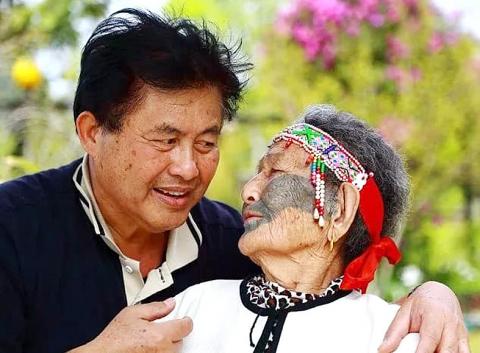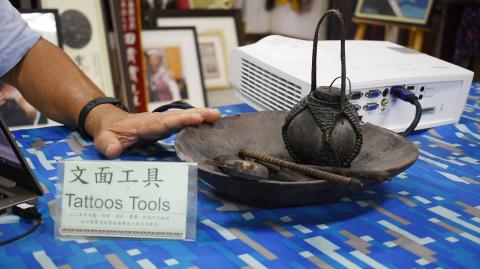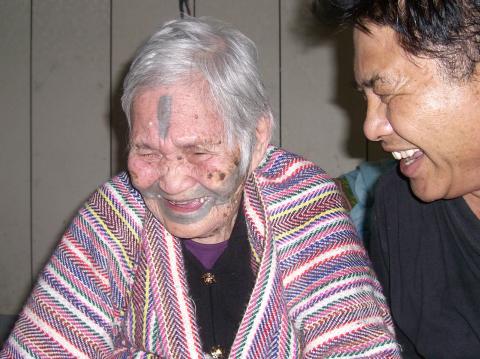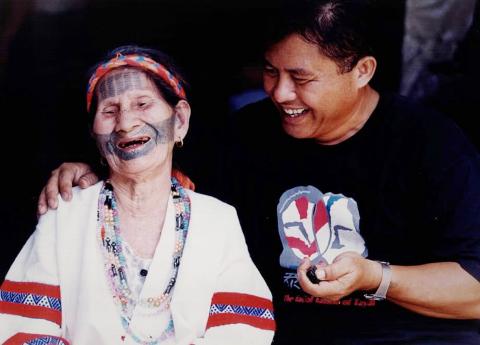Under a clear mountain sky, an Atayal boy of 12 prepares to transition into a man by way of a painful ceremony passed down by his ancestors. Like many boys his age, he has proven his valor and courage by mastering the art of hunting. In another village, a girl of similar age awaits her own passage into maturity after mastering her craft of weaving. Both subjects wait as a mixture of charcoal and pine tree oil is prepared, applied and slowly pushed under the sensitive skin on their cheeks and foreheads.
This narrative describes traditional facial tattooing, the most significant coming-of-age ceremony for the Atayal, one of Taiwan’s sixteen recognized indigenous tribes. Often referred to as a “cultural treasure,” this custom began to disappear when the Japanese controlled Taiwan from 1895 to 1945.
“My grandmother had facial tattoos, and they were very beautiful,” said cultural advocate and historian Kimi Sibal in a recent interview.

Photo courtesy of Kimi Sibal
When Sibal was seven years old he became intrigued by the distinct ash-colored markings on his grandmother’s face. It wasn’t until a family photoshoot that he ask her: “Why do you have those tattoos?”
Rather than the captivating story that Sibal had expected to hear, he was faced with a different response. “We mustn’t speak of it. I can’t tell you.”
INTOLERANT ATTITUDES

Photo: Sylvia Dean
During Japanese rule, sacred practices such as facial tattooing were prohibited due to intolerant attitudes towards indigenous communities. In an effort to exercise authority over a group seen by colonizers as savage, indigenous communities living in the mountains were driven down to flatter land, where they were easier to regulate and control. After years of oppression, his grandmother had been conditioned to be ashamed of the tattoos.
As a Hualien native and a member of the Seediq community, Kimi didn’t learn about his heritage until much later in life. After his grandmother passed away, Sibal felt as if he had lost the opportunity to find answers about his ancestors. It wasn’t until decades later, after he became a husband and a father, that he began to uncover the truth.
Sibal recalls an incident involving his son when he first began school that awakened him to the importance of learning about his background. The boy got into a fight with his classmates because they targeted his heritage, sneering that the tattoos worn by his ancestors made them look like monsters, and that he was from a bloodline of savages. Sibal resolved to both discover the story behind his own ancestry, and to share the true meaning behind the custom of facial tattooing.

Photo courtesy of Kimi Sibal
“I took my camera, I took my voice recorder and I set out. I found that there were still many people who had tattoos,” he says.
Today, Sibal has dedicated years of his life to the documentation of this sacred practice, and displays an extensive collection of his work in Hualien. Today, there are only two remaining elders with facial tattoos — one of them is 98 years old, and the other is 99.
“They won’t be here for much longer. I came to think, why have I been researching these people for all these years? Well, the words they speak are filled with history. The words they speak are rich and wonderful,” Sibal says.

Photo courtesy of Kimi Sibal
Sibal has captured hundreds of portraits of tattooed elders and has written many books about this symbolic custom.
“After years of research, I finally began to realize why thousands of people passed down these tattoos, their meaning and their spirit,” Sibal says.
SIGNIFICANCE OF TATTOOS
He lists four main reasons for the preservation of facial tattoos: Tribal recognition, protection against evil spirits, access to the afterlife and beauty.
Although the meanings behind these facial tattoos are representative of honor and high achievement, with the advent of colonization, they have often been falsely interpreted. As Sibal’s son discovered at school, it’s common for groups that practice facial tattooing to be falsely marked as barbaric, uncivilized and criminal.
“As long as we are here, no matter what we do, we are not treated fairly on this earth. There is no mutual respect,” Sibal says. “What they write about our culture, about our language, is in the eyes and interpretation of the government. They can write whatever they want, but today I am doing this honorable work, because the ones that have these tattoos are my own ancestors.”
Through his work documenting the lives of Atayal elders, Sibal’s legacy will remain for many years to come.
“The most important thing is for these tattoos to be recorded,” Sibal says. “We must let the next generation know that the markings their ancestors have on their face represents bravery and capability.”

That US assistance was a model for Taiwan’s spectacular development success was early recognized by policymakers and analysts. In a report to the US Congress for the fiscal year 1962, former President John F. Kennedy noted Taiwan’s “rapid economic growth,” was “producing a substantial net gain in living.” Kennedy had a stake in Taiwan’s achievements and the US’ official development assistance (ODA) in general: In September 1961, his entreaty to make the 1960s a “decade of development,” and an accompanying proposal for dedicated legislation to this end, had been formalized by congressional passage of the Foreign Assistance Act. Two

Despite the intense sunshine, we were hardly breaking a sweat as we cruised along the flat, dedicated bike lane, well protected from the heat by a canopy of trees. The electric assist on the bikes likely made a difference, too. Far removed from the bustle and noise of the Taichung traffic, we admired the serene rural scenery, making our way over rivers, alongside rice paddies and through pear orchards. Our route for the day covered two bike paths that connect in Fengyuan District (豐原) and are best done together. The Hou-Feng Bike Path (后豐鐵馬道) runs southward from Houli District (后里) while the

March 31 to April 6 On May 13, 1950, National Taiwan University Hospital otolaryngologist Su You-peng (蘇友鵬) was summoned to the director’s office. He thought someone had complained about him practicing the violin at night, but when he entered the room, he knew something was terribly wrong. He saw several burly men who appeared to be government secret agents, and three other resident doctors: internist Hsu Chiang (許強), dermatologist Hu Pao-chen (胡寶珍) and ophthalmologist Hu Hsin-lin (胡鑫麟). They were handcuffed, herded onto two jeeps and taken to the Secrecy Bureau (保密局) for questioning. Su was still in his doctor’s robes at

Mirror mirror on the wall, what’s the fairest Disney live-action remake of them all? Wait, mirror. Hold on a second. Maybe choosing from the likes of Alice in Wonderland (2010), Mulan (2020) and The Lion King (2019) isn’t such a good idea. Mirror, on second thought, what’s on Netflix? Even the most devoted fans would have to acknowledge that these have not been the most illustrious illustrations of Disney magic. At their best (Pete’s Dragon? Cinderella?) they breathe life into old classics that could use a little updating. At their worst, well, blue Will Smith. Given the rapacious rate of remakes in modern